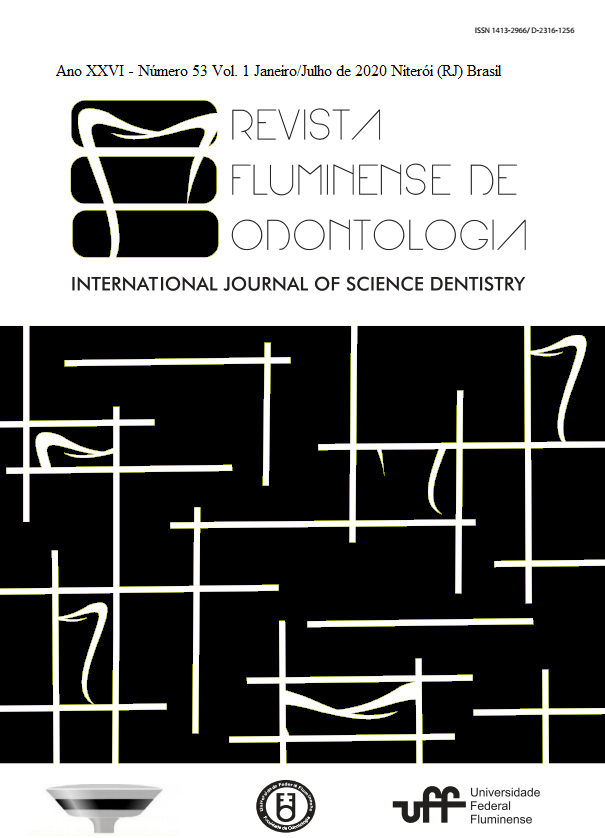FIBRINA RICA EM PLAQUETAS (PRF) COMO TRATAMENTO DE COMUNICAÇÃO BUCO-SINUSAL: RELATO DE CASO
DOI :
https://doi.org/10.22409/ijosd.v0i53.39870Résumé
Resumo
As comunicações buco-sinusais são complicações pós-cirúrgicas que ocorrem mais frequentemente após exodontia de molares superiores devido a relação anatômica íntima entre o ápice das raízes desses dentes com o seio maxilar. O seu diagnóstico envolve procedimentos clínicos e radiográficos, sendo a manobra de Valsalva um passo importante do exame físico. Essas comunicações diretas entre o seio maxilar e a cavidade oral, se não tratadas de forma adequada, podem evoluir para fístulas permanentes que ocorrem quando há epitelização da mucosa. A literatura defende diferentes formas de tratamento cirúrgico, sendo a maioria através de retalhos que demandam um segundo sítio de cicatrização. Objetivando-se diminuir a morbidade desses procedimentos e a melhora da cicatrização tecidual, uma opção de tratamento é a utilização de PRF (Fibrina Rica em Plaquetas). Trata-se de uma membrana de fibrina autógena, rica em leucócitos, plaquetas e fatores de crescimento, obtida através do sangue do paciente que passa por um processo de centrifugação. O objetivo do presente trabalho é relatar um caso clínico do paciente V.A.P., leucoderma, sexo masculino, 56 anos de idade, que compareceu à Faculdade de Odontologia da Universidade Federal Fluminense, apresentando ao exame clínico e por imagem, comunicação buco - sinusal com cerca de 2,5 cm em seu maior diâmetro. Com isso, foi proposto ao paciente a ressecção da fístula e fechamento através da utilização de membranas de PRF. Após prévia utilização de antibiótico e corticoide nasal, o procedimento cirúrgico foi realizado sob anestesia local em ambiente ambulatorial, sem intercorrências e o mesmo segue em controle pós-operatório com cerca de 2 meses, com boa evolução e sem sintomatologia.
Palavras-chave: seio maxilar, comunicação buco-sinusal, fibrina rica em plaquetas.
Abstract
Buco-sinus communications are postoperative complications that occur most frequently after maxillary molar extraction due to the close anatomical relationship between the apex of the roots of these teeth and the maxillary sinus. Its diagnosis involves clinical and radiographic procedures, and the Valsalva maneuver is an important step of the physical examination. These direct communications between the maxillary sinus and the oral cavity, if not properly treated, can progress to permanent fistulas that occur when mucosal epithelialization occurs. The literature defends different forms of surgical treatment, most of them through flaps that require a second healing site. In order to reduce the morbidity of these procedures and improve tissue healing, one treatment option is the use of PRF (Fibrin Rich Platelet). It is an autogenous fibrin membrane, rich in leukocytes, platelets and growth factors that is obtained through the patient's blood that goes through a centrifugation process. The aim of the present study is to report a clinical case of VAP patient, leucoderma, male, 56 years old, who attended the Fluminense Federal University Dental School, presenting oral and sinus communication with 2.5 cm at its largest diameter. Thus, the patient was proposed for resection of the fistula and closure through the use of PRF membranes. After previous use of antibiotics and nasal corticosteroids, the surgical procedure was performed under local anesthesia in an outpatient setting, uneventful and the same follows in postoperative control for 2 months, with good evolution and without symptoms.
Keywords: maxillary sinus, oral-sinus communication, platelet-rich fibrin.


